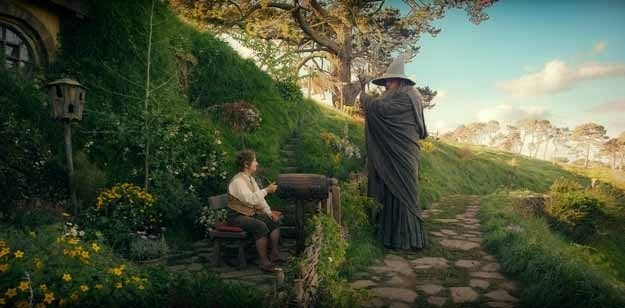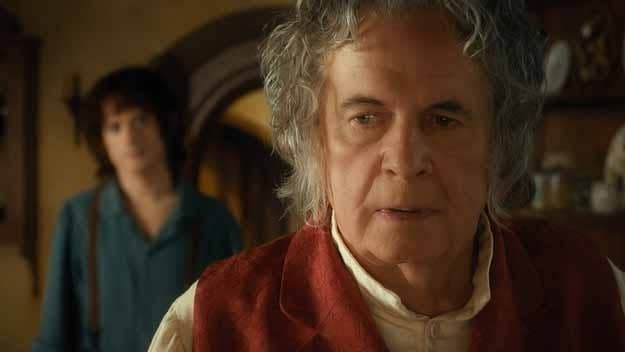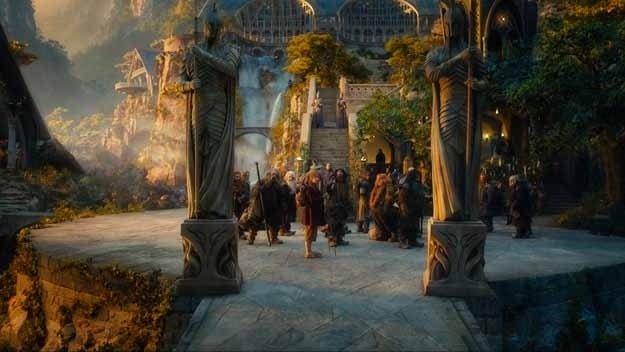
As a teen growing up on Terry Pratchett, Neil Gaiman, and Garth Nix, I came late to the Middle Earth party. J.R.R. Tolkien is the undisputed fantasy king, but his writing style is an acquired taste. To me, it's intimidating at best and actively hostile at worst. So when Peter Jackson turned Lord of the Rings into a movie trilogy, I was one of many sci-fi/fantasy fans ecstatic to finally have a medium where I could wallow in the full scope of the Tolkien world without having to wade through its creator's turgid prose. The films became Tolkien for me and I loved them, reveling in the nerd paradise the three movies created.
I expected the same of The Hobbit; that while fans of the book might gripe about Jackson's fidelity to a slim childrenʼs novel, I assumed that for the rest of us nerds not of the Tolkien branch, the ride would be just as fun this time around.
I assumed wrong.

The film's problems show themselves almost immediately. In 3-D and at 48 frames per second, Ian Holm in the role of the elderly Bilbo Baggins stands out against a backdrop, seemingly superimposed over it instead of part of it. Throughout the film, the human actors continue to look as though theyʼd wandered in front of a green screen of the most amazing video game scenery ever filmed. At the same time, the problem makes the costumes, visual effects, and CGI creatures appear B-budget. Words cannot state how much this draws one out of the film.
Of course, there are times when you can almost ignore the jarring appearance thanks to strong performances by both the returning cast and Martin Freeman as Bilbo and Richard Armitage as Thorin Oakenshield. Totally compelling are the push-and-pull conversations Bilbo has with Gandalf and the Dwarves; the quiet sense of homesickness and helplessness when the Dwarven company speak (or sing) of their lost land; the delightful scene where Gandalf is taken down a peg in front of his superior, making him more human, for lack of a better word. Galadrielʼs subtly suggestive conversation with Gandalf leaves one wondering how many times theyʼve done the Middle Earth equivalent of hooking up and what that might entail. The whole sequence toward the end of the film where Bilbo and Gollum interact is one of the best bits of acting this year.

But these moments of joy are few, bogged down with exposition that feels like random history lessons. Spontaneous musical numbers and slapstick seem oddly out of place. On top of this, you donʼt care what happens to much of the cast. Sure, you want the Dwarves to eject the dragon Smaug from their kingdom and in the process reclaim the city of Erebor as their own (who wouldn't?); but we all know thatʼs at least a year and a sequel away. The main conflict in the first Lord of the Rings film was character driven. The long trudge to Mordor was largely a device that gave us time and space to get to know the cast. The Fellowship did not get along, personalities and cultures clashed, and a ragtag group was forced to work together and in the process learn to love each other. And we went along with them.
In The Hobbit, however, the 13 Dwarves are already a functional unit. Gandalf knows them well. The one wrench is urbane, naive Bilbo. But without the personality clashes and precious insights they provide, there is very little to help emotionally invest viewers in an alarmingly large main cast. Other than Thorin and his war-hardened advisor Balin, the Dwarves become a blur of beards and shockingly ugly Cosby sweaters. Couple that with a sprinkling of subplots and more side characters than you can shake a staff at, and the whole plot starts to collapse under its own weight in the middle.

The film's major antagonist is the Pale Orc, who is hell-bent on destroying Thorin Oakenshieldʼs bloodline at any cost. The reason for his specific bloodlust is never explained. His minions study the “dance about in a circle while giving the heroes a chance to formulate a plan and escape” school of fighting, giving all the fight scenes an air of “whatʼs the point,” since there is no chance of anyone being seriously injured or dying. On the flip side, the Goblins are terrifying as secondary villains. Led by a disgusting-looking yet refined-sounding King, voiced by Barry Humphries, the goblin horde seems more like proper evil, setting elaborate traps in the mountains for unwary travelers, breaking out the torture implements, and delighting in seeing the heroes squirm.
At an almost three-hour runtime, The Hobbit could have been a great film if Jackson had condensed some of the meandering plot points or left them on the cutting-room floor. Instead, it will be a film that divides fans into those who love it and those who didnʼt. Iʼll be standing with latter, hoping the second installment, The Desolation of Smaug, carries the series beyond barely passable.
